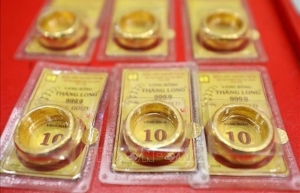Global practices must be considered for gold market
With gold prices maintaining a stronghold above $2,000 per ounce in the early months of the year, many experts projected a climb to $3,000 within 12-18 months. What are the primary drivers you foresee for gold prices in 2024?
 |
| Shaokai Fan, regional director for Asia-Pacific (excluding China), and head of Central Banks at the World Gold Council |
The World Gold Council’s latest data reveals a sustained strong demand for gold, with 2023 witnessing a record-breaking total demand of 4,900 tonnes, including over-the-counter markets and reserve holdings.
Central banks continued their swift pace of gold acquisitions in 2023, amassing 1,037 tonnes, closely approaching the record set in 2022 and short by only 45 tonnes. We expect central banks to persist in their gold purchasing in 2024, motivated by a global shift towards looser monetary policies, thus bolstering future gold prices.
With central banks maintaining a robust pattern of net gold purchases, do you identify any potential shifts that might invert this trend?
For 14 consecutive years, central banks have been net purchasers of gold, hitting record levels in the last two years. Central bank gold reserves have seen an annual increase of 1,000 tonnes for two years in a row. In 2023, the demand from central banks for gold reached 1,037 tonnes, a slight decrease from 2022.
The anticipation for 2024 is a continued increase in gold purchases by central banks to diversify their reserves, maintaining a positive thrust for the gold market.
This net purchasing trend could only potentially reverse in the event of a large-scale financial crisis, compelling central banks to liquidate their gold reserves. However, such a scenario appears improbable.
The domestic price of gold bars in Vietnam starkly contrasts with the international gold price. In your view, how should the gold management policy in Decree No.24/2012/ND-CP be modified?
The disparity between local and international gold prices primarily stems from import restrictions. The Vietnamese prime minister has acknowledged this issue and issued directives accordingly.
On the other hand, the State Bank of Vietnam is likely to explore various amendments to Decree 24, aiming for a more liberalised gold market without causing disruptions.
Experts and businesses are optimistic about more freedom in the gold market, anticipating that any new regulations enabling gold imports would bridge the price gap between local and global markets, safeguarding investor interests.
With Vietnam’s foreign exchange reserves standing at around $100 billion, a noticeable improvement yet not abundant, how can the country justify the use of foreign currency for gold imports in light of the cautious monetary policies in place to manage exchange rate fluctuations?
Vietnam’s macroeconomic fortitude has considerably bolstered its foreign reserve position, despite not being plentiful. This strength allows for some strategic leeway in utilising foreign currency for gold imports. However, the ongoing robust demand for gold within the country, often satisfied through unofficial channels due to strict import controls, suggests the necessity for regulatory reforms.
Properly amending Decree 24 could provide more efficient governance of the gold supply, allaying fears of economic dollarisation - a concern rendered obsolete by Vietnam’s current economic resilience and stability.
As for managing the gold market, Vietnam might consider international practices where gold is integrated into the financial sector rather than viewed solely as a physical commodity. Learning from countries like China, India, and Turkey, which have effectively satiated their gold needs despite being net importers, could inform Vietnam’s approach to maintain market stability without the onus of substantial physical gold imports.
What is your outlook on the growth potential for Vietnam’s gold market in 2024?
Vietnam’s gold consumer demand saw a 6 per cent marginal dip from 59.1 tonnes in 2022 to 55.5 tonnes in 2023. Demand for gold bars and coins edged down by 2 per cent, while jewellery demand contracted by 16 per cent. The country witnessed a rebound in gold investment during the last quarter of 2023, as market prices adjusted. However, constrained investment options coupled with stagnant demand growth have caused notable disparities in the pricing of SJC gold bars.
The future growth prospects for Vietnam’s gold market remain robust, underpinned by the population’s rising affluence and demographic advantages.
 | Gold, bitcoin pull back from records as US stock markets slip Gold prices and bitcoin hit all-time highs Tuesday before paring some gains, while a sell-off in some tech stocks led to a slump in many stock markets around the world. |
 | Domestic gold prices set new record Domestic gold prices increased on March 7 morning to a new record at 81.25 VND (3,290 USD) million per tael (one tael is equivalent to 1.33 ounces) for SJC gold bars and 68,8 million VND for gold rings, after global prices hit an all-time high of 2,152.09 USD per ounce a day earlier. |
What the stars mean:
★ Poor ★ ★ Promising ★★★ Good ★★★★ Very good ★★★★★ Exceptional
Related Contents
Latest News
More News
- From easy money to selective bets: investment prospects for Vietnam in 2026 (January 06, 2026 | 16:51)
- Stock market starts 2026 with growth and governance in focus (January 06, 2026 | 08:45)
- Cake by VPBank posts strong gains in scale and efficiency leveraging AI focus (January 05, 2026 | 18:55)
- Banks step up listing plans in 2026 to strengthen capital and transparency (December 31, 2025 | 18:59)
- Ho Chi Minh City projects $10.5 billion remittance inflows in 2025 (December 31, 2025 | 18:58)
- New decree sharpens enforcement in securities market (December 31, 2025 | 18:53)
- Gold market reform advances as SBV receives applications for bullion production (December 30, 2025 | 12:07)
- EVN and AFD sign credit agreement for Vietnam’s first pumped storage hydropower plant (December 30, 2025 | 10:06)
- Techcombank Priority Visa Signature unlocks a higher standard of living (December 29, 2025 | 16:44)
- Tax sector wraps up 2025 and sets priorities for next year (December 25, 2025 | 14:00)

 Tag:
Tag:

















 Mobile Version
Mobile Version